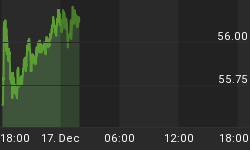A post on deflation in Sweden (which its central bank does not want) got me to thinking about inflation targeting once again.
Sweden's central bank, the Riksbank, has an inflation target of "2 per cent as measured by CPI." Bernanke has a similar target, as do many central banks.
The first major problem with inflation targeting is that increases in money supply and credit (the true measure of inflation) frequently appear in the form of asset bubbles, not consumer prices.
Even if that were not the case, it's easy to show why 2% inflation targeting is a bad thing.
Inflation Targeting at 2% a Year

Real Disposable Income

Real Disposable Income Per Capita

Real Disposable Income Per Capita Detail

As long as wages and income keep up with inflation targeting, and as long as asset bubbles do not form, central banks can get away with their highway robbery tactics.
At some point however, asset bubbles do form and that's where big problems start. The Fed has sponsored three major bubbles in recent history.
Three Major Fed-Sponsored Bubbles
- 2000 DotCom Bubble
- 2005 Housing and Credit Bubble
- 2012 Stock Market Bubble
In the wake of the dot-com bust, the Fed (via loose monetary policy) sponsored a housing and credit bubble that caused the global financial crisis. The Fed did not see the housing bubble partially because prices are not in the CPI, but primarily because Bernanke and Greenspan have the common sense of a rock.
Following the housing/credit bubble bust, the Fed's "too big to fail" policy bailed out the banks at taxpayer expense. The Fed's subsequent QE to infinity policy created yet another stock major bubble that few see (simply because it has not yet burst).
All the while, price inflation marches on, even if credit inflation does not (roughly the current state of affairs).
Thus, in addition to the asset bubble problem, the second sad moral of this story is simple: Pursue price inflation long enough, then jobs move elsewhere and real wages are guaranteed to not keep up.
Starting in a major way in the year 2000, jobs and capital moved overseas because US wages were uncompetitive globally. Let's not stop there because it gets even worse.
Income Gap Discussion
In addition to the "Income Gap" one must also consider "Income Skew".
Under the Fed's inflationary policies, a select few percent have done exceptionally well, another few percent have done well, and another (perhaps slightly larger group) have barely kept up.
The bottom 80 percent or so have fallen much further behind than the above per capita charts suggest.
Income Skew
I explained why the rich get richer and the poor get poorer in Top 1% Received 121% of Income Gains During the Recovery, Bottom 99% Lose .4%; How, Why, Solutions
In response to that article a Reader Asked Me to Prove "Inflation Benefits the Wealthy" (At the Expense of Everyone Else)
CPI Percent Change From Year Ago

Except for a brief period in 2009, price inflation has been positive. The question is "Who Benefited?"
I claim it is those with "first access to money" namely banks and the already wealthy. A few charts courtesy of Doug Short at Advisor Perspectives will prove my point.
Real US Household Incomes
In "real" (CPI-adjusted) terms, 50% of households are no better off than they were in 1988. Let's dig a litter deeper.
Growth in Real Household Income by Quintile
The above chart shows percentage income growth by quintile since 1967. Since 1988, the bottom, 4th and middle quintiles (a combined 60% of households) have negative real income growth.
The next chart shows the same thing in a different way.
Real Household Income by Quintile
No matter what your timeframe, only the top quintile did well. And from 1980 until 2000 the top 5% got the lion's share of income gains.
Inflation is Theft
Inflation is an insidious hidden tax that benefits those with first access to money (the banks and the already wealthy), and government (via sales taxes, property taxes, and income taxes).
Government bureaucrats take your money and redistribute it primarily for wasteful pet projects in their districts or to those who contribute to the politicians' campaigns.
In spite of the often-heard mantra that "inflation wipes away debt", I suggest otherwise. Income typically does not keep up with expenses, and most have too few assets to inflate. The poor (last on the credit totem pole) overpay for their assets with cheap credit given to them at precisely the wrong times (as happened right before the housing bust).
Inflation Clobbers Those on Fixed Income
In case you missed it, please consider Hello Ben Bernanke, Meet "Stephanie", my response to a reader on fixed income attempting to live on Social Security plus interest on a $16,000 CD.
If routine price inflation did not benefit the banks and the wealthy at the expense of everyone else, we probably would not have it.
Simple Solution (Easier Said than Done)
Conceptually, the way to eliminate the problem is simple: abolish the Fed and get rid of fractional reserve lending.
In practice, the idea is easier said than done, because the wealthy are in control of the system and they are the ones who benefit from inflation.
Wine Country Conference
I am hosting an economic conference on April 5 in Sonoma, California. Proceeds go to the Les Turner ALS Foundation (Lou Gehrig's Disease).
Please see My Wife Joanne Has Passed Away; Stop and Smell the Lilacs for my association with the disease.
To learn about the economic conference with world-class speakers including John Hussman, Michael Pettis, Jim Chanos, John Mauldin, Mike "Mish" Shedlock, Chris Martenson with guest moderator Lauren Lyster and other Special Guests, please visit Wine Country Conference April 5, 2013


















